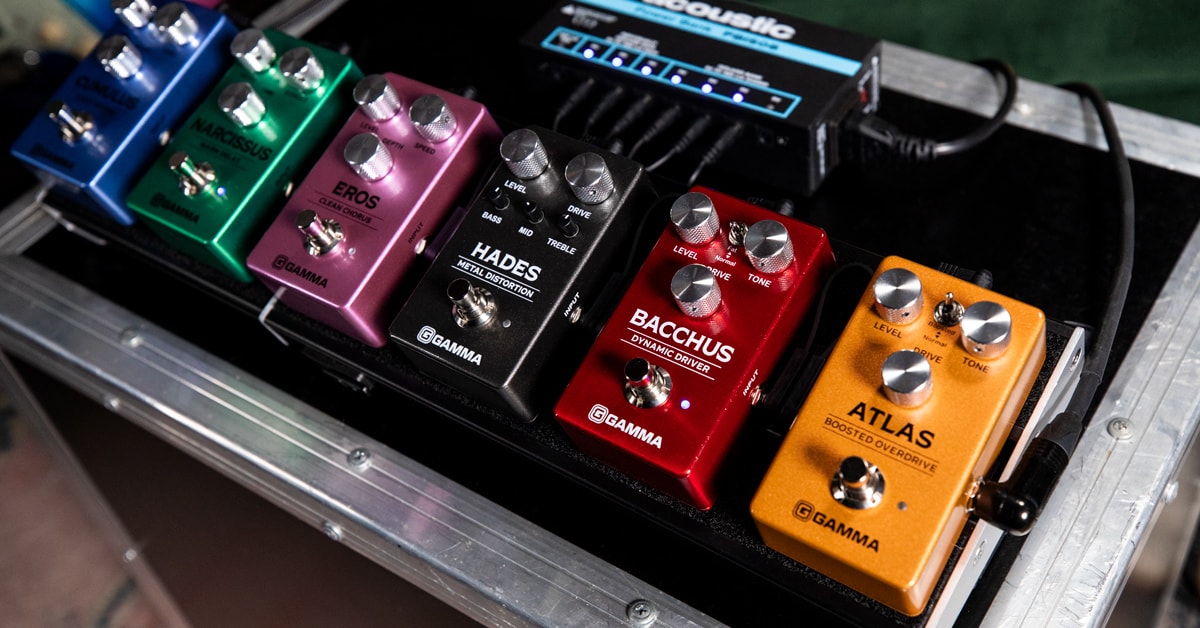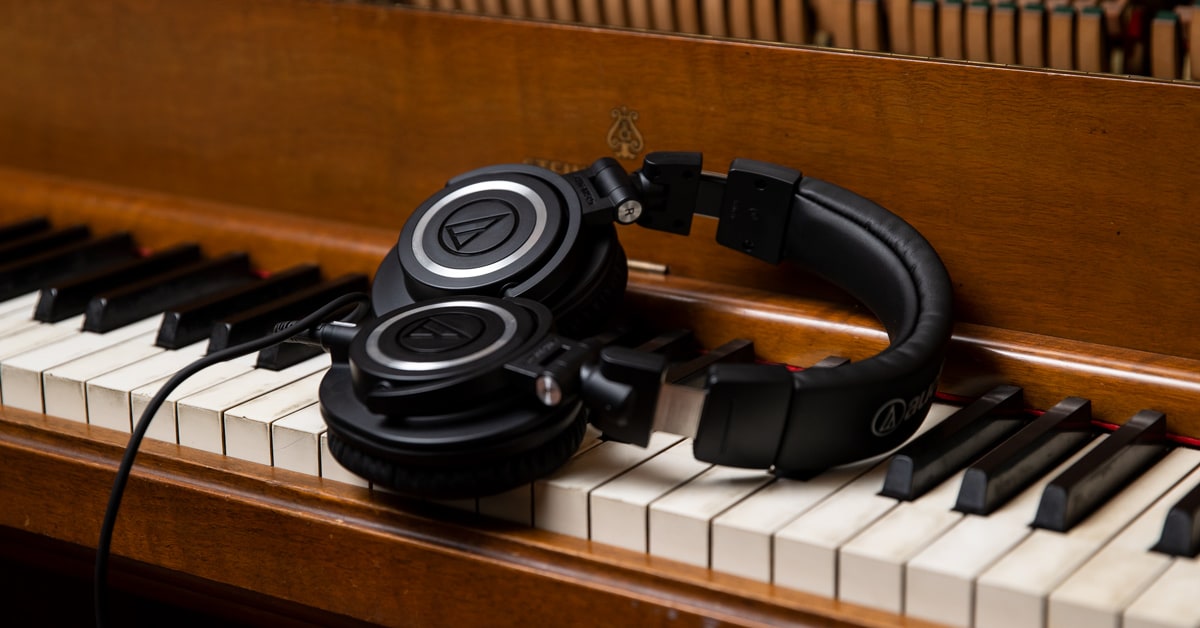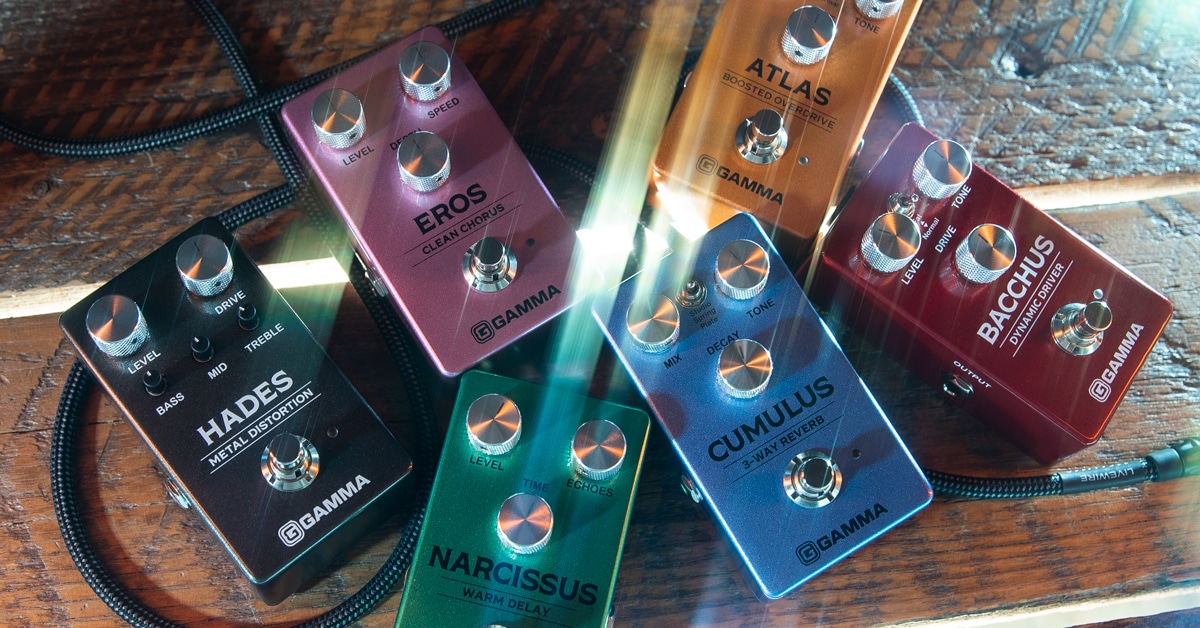In 2022, GAMMA released its straight-ahead, analog guitar amplifier series. It was a bit of a surprise in an amp market that seemed to be pushing the envelope on affordable DSP-based designs. But GAMMA Product Manager Patrick O’Connor and his team believed focusing on an analog design and upgrading speaker quality to provide guitarists with aggressive, organic tones—as well as an excellent sonic platform for pedalboards—would delight players looking for a versatile, authentic-sounding and affordable amp.
Envisioning the next step for GAMMA didn’t require a crystal ball.
With GAMMA amps rapidly accepted by players, the ensuing strategy was to deliver on the pedal-platform promise of the amp design by developing the brand’s own stompbox line—a similarly affordable collection of essential guitar effects with great tone and enriched features.
There was one more crucial element in the pedal plan—fun.
The six pedals in the new GAMMA guitar pedal effects series were inspired by all-powerful, petulant, love-obsessed and unhinged ancient gods. Even the weather was name-checked in the design scheme. Here, O’Connor and GAMMA Project Manager Karl Sukhia descend from the design lab’s sonic Mt. Olympus to share the story of the Atlas Boosted Overdrive, Bacchus Dynamic Driver, Cumulus 3-Way Reverb, Eros Clean Chorus, Hades Metal Distortion and Narcissus Warm Delay with earthbound guitarists and pedal lovers.
What sparked the idea of making GAMMA guitar pedals?
Patrick O’Connor: Matt Schneider—VP of Guitars here at Guitar Center—asked what we could do to provide players with affordable pedals that don’t compromise on quality. So, we studied how pedal brands that are now considered staples—such as BOSS and MXR—became popular. We looked at the kinds of pedals they were making, as well as the experience those pedals gave players. Our vision was, “What pedals can we create that players will keep using for decades—not just buy and toss away a year later?”
As you narrowed down the types of GAMMA pedals you wanted to design and build, did you have specific players or circuits in mind?
O’Connor: The world of pedals is like music—there are only so many keys, chords and even styles available. So, for us, coming up with the GAMMA pedals was like writing songs. Even though you may be playing the same three chords as somebody else, your song can still be unique. In this case, we studied the tones of pedal variations, tributes and clones, and thought about what we could do that’s familiar to players, but also its own thing.
Karl Sukhia: But, just to be clear, we did not do a Tube Screamer clone [laughs].
O’Connor: We took inspiration from what was out there, but we didn’t want to match anything currently on the market. We were really going after the meat-and-potatoes sounds that players use most often.
How did you come to the Greek mythology themes for the pedals?
O’Connor: We didn’t want to end up with a “B-79” letter-and-number type of thing to identify each model. We wanted names that are fun and memorable. We hit on GAMMA—which means “G” in Greek—when we were designing the guitar amplifiers, because scientists use Greek terms a lot for naming elements, storms and so on. We said, “Hey, we’re kind of scientists with instruments, because we’re holding guitars and wearing lab coats.” For the pedals, we thought it would be fun to continue along those lines. After all, guitar heroes play pedals, and many of the Greek gods are mythological heroes. Also, the feeling of playing guitar when it sounds epic is like wielding Zeus’ lightning bolt.
What was the process for developing the GAMMA pedals?
O’Connor: Jean-Claude Escudie, who is the Director of Premium Stringed Instruments and Pedal Effects at Guitar Center, has a classic ’70s component stereo in his office, and he said, “See the metal knobs on this stereo? It would be really cool if you could do metal knobs and metal flake finishes—no plastic anywhere. That would be badass and withstand the test of time.” Of course, as a friend of ours likes to say, the first part of anything is, “Make some drawings.” I had done some preliminary sketches, but as we started the process during COVID, Jean-Claude and Matt had to come over to my backyard, where we’d all stand six feet apart and debate things such as, “Should a metal distortion pedal be black or red?” Those backyard sessions are how it really got started—guitar nerds debating sounds, colors and names.
Sukhia: During the prototyping process, my house became a laboratory for about two months. I didn’t have a dinner table. It was a pedal table. Next to it was a pedal station set up with several test guitars and amps. All of the parts, prototypes, power supplies and everything else were scattered around my living room.
O’Connor: After the drawings were done, we looked at the capabilities of the factory we’d need to work with to manufacture the pedals. We also talked with a local engineer who has a great understanding of the history of pedals, as well as how to get the best quality out of a product while also keeping it the most affordable for the customer. That engineer presented ways we could hit the mark in sound through component choice and design. So, Karl plugged into a lot of samples to recognize the strengths and opportunities in the sounds. For instance, we had a great tone stack in Hades, but we thought if we could scoop the mids deeper than they were traditionally scooped, we could get the pedal to the tonal territory of Swedish death metal. But we also wanted to offer a modern rock sound if you swept the mids in the other direction—classic tones, but with a wider control range than is typical. It was the same thinking for the Eros Clean Chorus. The classic chorus pedals everybody knows have two control knobs, but we wanted to give players a bit more to work with by adding a Level control to adjust the wet/dry mix. We learned so much about details during the testing process, such as the input/output impedances of traditional designs. Let’s say a classic pedal had an impedance of 230 ohms. We found a higher impedance, such as 650 ohms, would give us a more consistent tone—for long cable runs, in particular.
Sukhia: Testing is really about sound choices. The aim of my lab became figuring out ways to break things. For example, we discovered some components that were spec’d for audio usage were not always designed for guitar-pedal applications—especially high-gain uses. Perhaps there’s noise in a microphonic capacitor. Well, when you add 50 decibels of gain on top of it, you’re literally amplifying the problem. Through testing and breaking the designs, we found areas we could improve. In the end, the right capacitor wasn’t going to cost more, but if we got it from a different manufacturer, it would be much more stable in its operation and sound. It was eye-opening.
What reference gear did you use to test the pedals?
Sukhia: The main test amp was our GAMMA, because it's an incredibly clean and versatile platform that we know inside and out. What we put into it is what we get out of it—especially on the clean channel—and it can handle high-gain testing, as well. For guitars, we used a Les Paul with hot pickups and a Strat with low- to mid-gain Noiseless single coils. My all-around testing guitar is a PRS 408, because it’s very resonant and lively, and I can switch between humbuckers and single coils to cover a lot of tones.
When you first got the pedals out of the lab, did you put them in front of players for their evaluations?
Sukhia: Yes. I have a lot of friends and family who work in the industry, so I have a rotating door of musicians coming through my place. It would be like, “Hey, come over and plug into this, and tell me what you think.” I was also field-testing the GAMMA pedals myself by taking them to jams and studio sessions.
O’Connor: As you can imagine, there are one or two guitarists who work at Guitar Center, so there was a lot of real-world testing and discovery. We would bring the pedals by peoples' offices and say, “Plug in. What do you think?” We did a lot of drop-in testing with Jean-Claude. “Does this knob have the right amount of range?” “Can you get the sound you want?” “Can you test them with your Fender Princeton?”
Sukhia: Jean-Claude's Princeton became another one of our reference amps, because it's a very good pedal platform.
Throughout that process, was there any interesting or surprising feedback?
O’Connor: It was really player-specific. Some people knew exactly what they were going for, and they’d say, “I always set my chorus pedal like this.” Other people were like, “Let's set every knob at 12 o’clock and see what it does.” Then, there were those who pretty much set all knobs on stun.
Sukhia: It was always very interesting to see what resonated with different players when they interacted with the pedals. For example, we initially thought of the Bacchus Dynamic Driver as a low-midrange gain driver, but some players found it offered much more tonal muscle. In fact, it became one of Matt's favorite pedals.
O’Connor: Yeah. Bacchus turned out to be an “If you could only take one pedal to a gig” kind of drive.
Well, let’s start with Bacchus, and go in for a detailed look at each pedal.
O’Connor: Our first conversations around the “Bacchus” name were based on the idea that bluesy drives are “good times” pedals. There’s a bit of drunken partying going on, so we thought, “Who is the god of drunken partying?” Bacchus. Let's make the pedal wine red. And away we went. The circuitry was based on the obvious bluesy drive classics, but we ended up giving Bacchus a more extreme gain range to get it into bigger rock territory.
Sukhia: We also added a Fat switch—which is a nice thing if you’re a single-coil player and you need a tiny bit more low-end emphasis. We thought it would be useful for those who want to do thick and creamy solos but aren’t going to pick up a Les Paul to do it.
What about the Atlas Boosted Overdrive?
O’Connor: Just like Atlas lifts the world on his shoulders, this pedal can lift your tone. In practice, it’s almost like adding another channel to your amp. The responsiveness is very much like an amp, rather than a dirt box.
What are the main differences between Atlas and Bacchus?
O’Connor: Different components and topology—things such as how many components are distorting and what configuration they're in relative to each other. Are they in series or parallel? Is the EQ before or after gain? Those choices shaped the differences between Atlas and Bacchus. For example, Atlas is more of a preamp than a dirt box, so it’s a great pedal to put in front of another drive. Atlas in front of Hades is a really cool thing.
That's a great lead-in to the Hades Metal Distortion.
O’Connor: Ruler of the underworld.
Sukhia: Metal AF.
O’Connor: That sums it up. Hades is a high-gain pedal with a powerful midrange control. Mids are key to what defines a metal sound, and our mid control is like a time machine. Depending on where you turn it, you can get distortion tones reminiscent of metal in the ’70s, ’80s, ’90s and ’00s. We really focused on that mid knob to give Hades more range and versatility than other metal distortion pedals.
Turning to the softer side, we have the Eros Clean Chorus.
O’Connor: Want to play a love ballad? The Eros pedal’s swirly and dreamy character is the perfect sound to use. When Prince played ballads—doing a beautiful vocal over a strummed guitar—that's the kind of guitar tone he often used. Eros represents passionate love. That pedal started with the spirit of the classic ’80s two-knob design, but we wanted to go deeper with the chorus effect, so we added a Level control.
Sukhia: Level was added specifically for those players who like to use chorus lightly—almost as if it’s not there—but still have it produce a more engaging sound than a raw guitar signal. The Level knob really helps you dial in that relationship.
What about the Narcissus Warm Delay?
O’Connor: Narcissus had a strong ego, and he fell in love with his own reflection in a lake. We figured that’s much like the experience of playing a delay pedal—it’s your own sound coming back at you like a reflection. So, the pedal had to be called “Narcissus.” As for the “warm” part of the name, we decided to use a classic Princeton PT2399 chip as the foundation of the pedal, and it causes each repeat to get a little darker and distorted. The benefit is that the repeats don’t obscure the new notes you play, because they step back from the foreground as they decay. In other words, the echoes become supporting characters. The other fun thing is the Princeton chip is part digital and part analog, so it responds like a tape echo and can produce that classic pitch smear. Cranking the rate and feedback knobs causes the pedal to self-oscillate, so you can go into full Radiohead mode where you're in this cool world of echo-y distortion building on itself.
Let’s talk about the Cumulus 3-Way Reverb.
Sukhia: Cumulus is the scientific name for the puffy clouds you see on a nice day, and that’s a great visual for the sense of space you can get from a good reverb.
O’Connor: We gave Cumulus three modes: Studio, Spring and Plate. Studio mode was developed under Karl’s direction, and it really nails the natural ambience you get in a small recording space. It gives a guitar “body” without too much wetness or splatter.
Sukhia: Spring covers the vintage vibe you get from a classic tube amp reverb. There’s a bit of wiggle in there—you’re getting into surfy territory. Plate lets you go big—more washed out and with a longer tail. It’s great for pads. The Mix control is really cool, because you can set the pedal to be 100-percent effect—mixing out the direct signal entirely—so there’s this wide wall of sound that’s almost disembodied from your playing. It’s real ethereal.

The GAMMA guitar effects pedals line is launching online and in stores nationwide as we speak. What are you hoping players experience when they try them out?
O’Connor: For us, this is about what was it like to buy a pedal in the ’80s. It would be something you could afford—under 100 bucks—and you’d say, “This is awesome. I can sound like that guitarist I'm hearing on the radio. I can nail the tone I've been going for.” And you would keep that pedal for decades, and it would continue to be a source of inspiration. That is what we are trying to do with the GAMMA pedals, and we hope that feeling comes through for every user.
Where do you see GAMMA going in the future?
O’Connor: The fun thing will be finding out from customers what they want next—which will tell us what we'll try to do. That's also the great thing about having the GAMMA pedals in 300 Guitar Center stores nationwide. We're going to have a whole bunch of people letting us know where they want us to go.
Sukhia: Exactly. We're starting the conversation with these six pedals. Now, we're listening...










